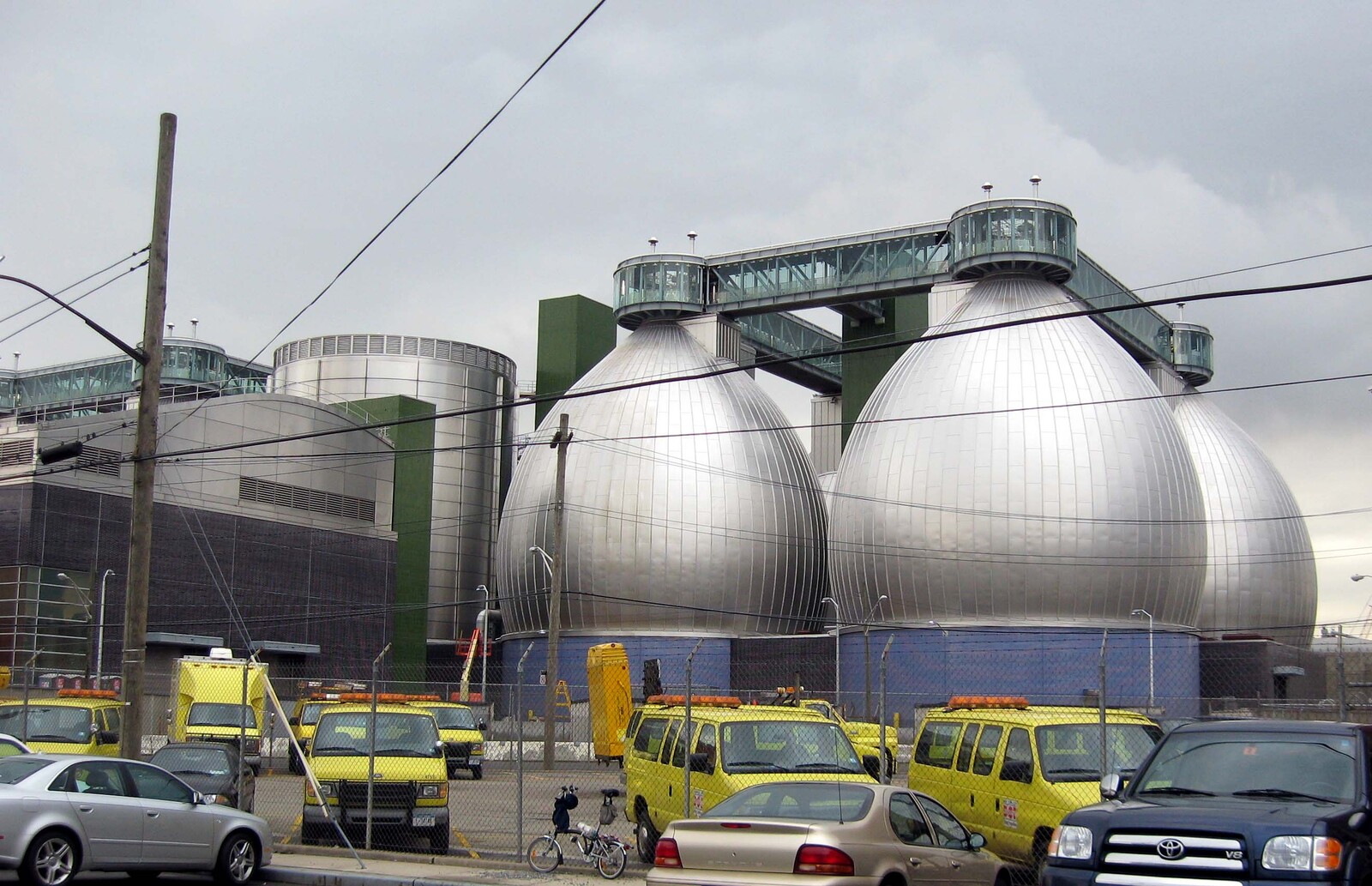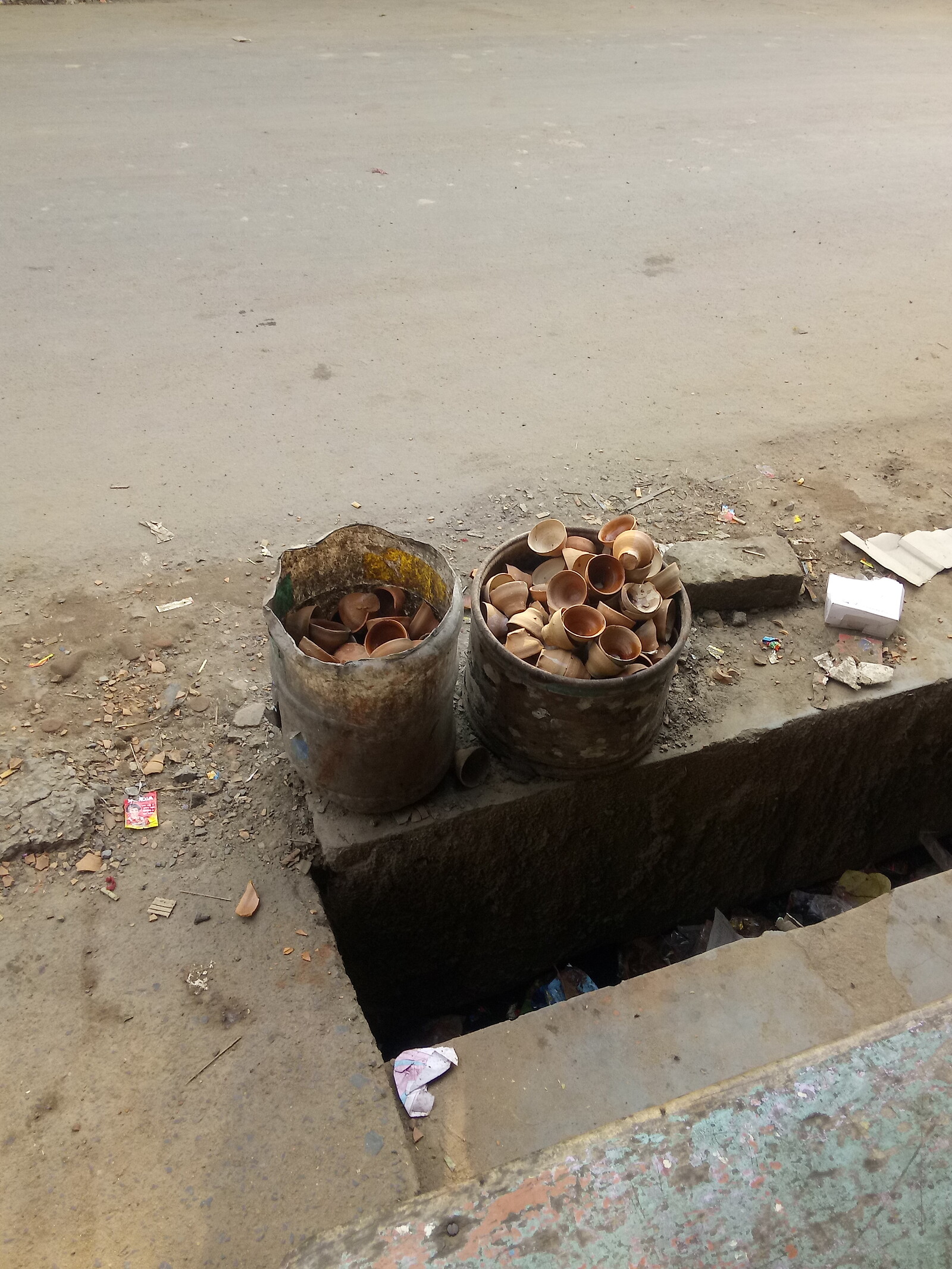Producers have few direct incentives to build products to last, to make them easy to repair, to use less packaging, or to make their goods or packaging easy to reuse, recycle or compost. In fact, it is often beneficial for producers to make goods intended to be used once or temporarily so that consumers continually buy more.1
The elevator doors in my urban apartment building open with a gratingly cheery ding! and I begin to mutter under my breath—something about unpaid waste work, the false promise and wishful thinking of recycling aaaaanyway, and the shit-end of proverbial family care.2 Clumsily dragging this week’s numerous bags of sorted recycling behind me while perilously balancing a leaking municipally approved compost bin on two fingertips, I use my hip to bump the door open to the sorted dumpster area. Buzzing florescent lightbulbs, straight out of a cheesy horror movie, spring into action overhead. A trail of dripping compost water punctuates segments of my bitter path, and the putrid scent of ammonia fumes from the overflowing bins waft into the crisp morning air.
In the city of Milan, residents must separate all recycling, placing it in barcoded bags for random accuracy checks (at the risk of fines), and dispose of green waste in biodegradable bags that are then processed in a city-wide anaerobic digester.3 I am a country kid, and the daughter of rural auctioneers; the intensive labor of reuse has always marked my life and is nothing new. Here, I am daily reminded of the work that goes into grappling with quotidian waste, but with none of the additionally beautiful benefits of that labor I grew up loving, albeit complexly. No herbaceous nitrogen rich soil available at all times, no corn rustling, bees bustling, trees chattering, or earthworms wriggling. Here I do not find foxes picking through freshly turned compost piles, and there are no small mammals churning the garden soil with their curious paws, stuffing cheek pouches with found morsels or snatching hard-won snap peas from the blooming vines; no mournful coyote cries call kin in the distance.
This city is internationally praised for the success of its municipal recycling, redistribution initiatives, and greenwaste-biogas management.4 I am not contesting such facts. However, I am also clearly missing some of the sweeter elements of food waste as I knew them in another life, another place far from here. Likewise, I cannot shake what political scientist Kirstin Munro has argued more broadly concerning the labor of waste as “work transfer.” She writes that “recycling sorting—the state-directed separation by households of valuable from undesirable waste—is unwaged work that provides useful raw materials to industry as a free gift and contributes to overaccumulation and crisis.”5 Source separation like this exemplary morning trek is, moreover, largely behavior reliant, and waste specialists have long documented that much of the food packaging consumers grapple with cannot be recycled, is not recycled, or disrupts the apoliticized “neatness” with which recycling has historically been framed.6


Maintainance of biogas plant in Naivasha, Kenya, 2009. License: CC BY 2.0.
This essay is an exploration of waste failure, or shall I say, imperfections and longings; it is about how visions of circularity may succeed at certain scales, yet also fail to fundamentally question the logic of accumulation at industry levels. More specifically, this is a meditation on the conundrums of food waste and its packaging, and an examination of the politics and potential of increasingly capitalized metabolic systems—of the objects and of beings from surplus food products to the gut tracts of grubs—that are deployed to supposedly clean up and (re)shape the riddles of human-produced rot, disintegration, and decay.
The matter of food waste is rich with possibilities and teeming with microbial life. Yet food waste is most often framed as a problem, a failure, a moral quandary, an object around which to frame “good” citizenship through the yardstick of better, more responsible consumer trends, especially in the home. “I’m a bad apple and I can cost you real money. Don’t let good food go bad,” declares Oregon’s “Bad Apple Campaign” PSA, for instance. Food waste is regularly defined as an individual household conundrum to be fixed and managed, more so than a systemic outcome or supply-chain predicament: “To End Food Waste, Change Needs to Begin at Home,” declares one exemplary headline.7 Colorful infographics made by the USDA, the EPA, for-profit management firms, and even National Geographic all declare food waste a problem that is placed at the doorsteps of households and individual consumers, estimated at one third of all food acquired by households, and consistent with other estimates of total food system loss in the US which commonly ranges from 30 to more than 40 percent.8 While loss is documented at all stages of the food supply chain, and definitions as well as measurements of food waste vary, mainstream emphasis is not predominantly placed on industry, policy, overproduction models, subsidies, or package design, but on consumer habits and household trends.9


Three of the eight large sewage digester tanks of the Newtown Creek Wastewater Treatment Plant that was built at the turn of the century, north of Greenpoint Avenue in Greenpoint, Brooklyn, New York.
So what! you might declare. Behaviors must change if we are ever going to reduce climate crises or achieve increased livability. Perhaps, but the fact that food waste is responsibilized within the post-consumption realm most frequently, and by way of encouraging better consumption and/or consumption of “better,” more “pure” products, along with a steady arsenal of the right recipes or adherence to waste-saving “tips,” should definitely give us pause. Food waste is most often represented in the popular imagination as a problem to be managed for key moral, environmental, and also for upcycled product-development reasons. 1) Moral reasons: nations like the US, China, Canada, and Australia waste so much food, yet food insecurity rates remain high, and debates over how to address such disparities are ongoing.10 2) Environmental impact reasons: food waste generates methane in landfills, contributes to greenhouse gases, and wastes water, money, and resources.11 3) New product development goals: upcycled or redistributive products like Regrained or Ugly Fruit revalue ingredients considered waste to turn a profit on new consumer goods reintroduced to the market, like the surplus foods intentionally left to rot in fields due to their cosmetic imperfections based upon arbitrary industry standards.12 The persistence of such standards, and of sheer industrial surplus production quantities, means that companies are thus able to rebrand food “waste” as marketable and valuable rather than useless or undesirable, thereby generating more consumer products deemed pure or revolutionary because they’re upcycled.
Addressing food waste on an individual and household level becomes the duty of so-called moral citizens, good mothers, and careful parents. These roles depend on middle-class and gendered ideals or aesthetics of achieving sustainability through the right type of consumption, what consumer capitalism scholar Christine Harold calls “mindful minimalism movements promoting abstinence or at least restraint.” Sociologist Katherine MacKendrick refers to this injunction as “precautionary consumerism,” wherein consumers are able to mitigate their own exposure risks through purchasing power “in an absence of precautionary policies.”13 Yet that complex, debated range of 30–40 percent overall food systems loss documented in the US, so often cited by food waste warriors, represents the normalized outcome of food systems that are permissibly, unjustly, and sometimes proprietarily wasteful by design (wasteful of low-wage labor, resources, chemicals, fertilizer, water, of precious life). Many shoppers have little choice, for instance, when it comes to the prepackaged manner or the quantities in which products are presented to them for purchase. Industries might reconsider cosmetic standardizations,14 packaging requirements, or confusing “sell by” dates, but often do not.


“While food conservation is urged by the government this happens in Chicago. A scene in one of the Chicago railway yards. These cars are all loaded with vegetables and in many instances the cards so loaded have been held on the tracks since September. Federal and State authorities have vowed to make someone suffer for the mockery of food conservation.” US Food Administration poster issued by the War Department, 1789–1947. US National Archives and Records Administration.
I do not raise these points because I am interested in parsing and defining exactly how to live so-called better, cleaner, or more moral lives through the exact right kind of recycling, salvage, or by way of what Alexis Shotwell calls the “the pursuit of purity.”15 I am most interested in how the revaluing of specific materials and organisms often sidesteps broader questions of continued accumulation and extraction on a systemic and industry level, rather than disrupting these phenomena. This might be achieved through a combination of systemic factors: more socially just policy, different waste infrastructure that is culturally appropriate to its contexts, product and packaging redesign, by way of shifting tastes or industry cosmetic standards, halting market speculation on food products and overproduction,16 and through critical disruption of the normalization of surplus- and plantation-oriented production models that produce both hunger, glut, and unjust labor conditions at devastating scales to ecologies and communities. As waste scholar Gay Hawkins aptly puts it, “Where the real disruption to disposability has to come from is in the design of economies and markets that are not built on structural wasting either in production or consumption.”17 The emphasis here is not simply on redesign initiatives per se, but on taste trends and the economic and market-based paradigms in motion that render waste continuously desirable.


Disposable terracota cups also known as “Bhar” are used in Kolkata, India, for drinking tea. License: CC BY-SA 4.0.
Turning to some of the most intriguing recent food design initiatives, one still finds a paradox of disposability and accumulation. For instance, the biodegradable dining-ware company Chuk makes its products out of bagasse, an industrial pulp leftover from sugar cane production—a process that reportedly wastes nearly one third of the plant to begin with.18 In 2017, founder of plant-based bioplastics Avani Eco, Kevin Kumala, declared that his company’s patented cassava and vegetable oil compostables are the only bioplastic bags in the world “that have passed an oral toxicity test,” meaning they dissolve in water and can be safely ingested—an act which Kumala himself demonstrates to the audience.19 Touting the potential to “become millionaires one day” by redistributing the prospects of industrial grade cassava starch, Kumala describes polyethylene products as “ugly,” styrofoam as “disgusting,” and plastic straws as “nasty” in comparison to the company’s revolutionary cassava starch bioplastics designed from surplus agricultural waste.
Both compostable product examples successfully harness the potential of industrial agricultural waste. They reflect a form of strategizing against plastics dumping largely from the Global North onto the Global South, as well as local- and regional-level waste-related public health concerns like the pollution of waterways, the dangers of landfill fires, and more equitable laborer wages and conditions. They also tow a line between feeding ideologies of disposability (they offer take-away commodities like disposable dinnerware and bags), while experimenting with waste(d) products within broader global solid-waste infrastructures that may not yet have the capacity to fully “manage” biodegradable products or compost-driven responses.20 In the US context, for example, BioCycle published a 2019 survey documenting only 185 (responsive) management facilities with the capacity to process compostables.21 Packaging alone reflects a substantial portion of metabolic burdens. For instance, policy analysts found that nearly 30 percent of the US’s overall garbage composition was specifically made up of containers and packaging.22 Thus, even when entrepreneurs respond to specific waste concerns through design innovation in individual products, the broader infrastructural, agricultural, and economic dynamics may prove persistent. This underscores the necessity for systems-level thinking about waste as opposed to consumer-driven models of tweaking home habits, product selection, or packaging to make things somehow less bad.
Returning to those wriggling worms and other riotous nonhumans from my introductory storytelling, a very different sort of biodegradation pattern emerges. A 2017 headline in Chemical & Engineering News reads “Waxworms Take a Liking to Plastic Shopping Bags.”23 The text is accompanied by a mesmerizing time-lapse video of delicate straw-colored waxworms eating their way through the bags. A similar article in Fast Company features another time-lapse video, this time of floating fire-colored crayfish, crickets, beetle larvae, and chickens eating cassava Avani Eco bags with the label “harmless when consumed by animals.”24 These articles and videos propose product edibility as a metabolic tool to fight waste. The metabolism or biodegradation of waste proves to be an environmentally vexing (though financially lucrative for some) conundrum of our ecologically devastated times, including in its role in colonialist land appropriation,25 increased pathogens, antibiotic resistance, and contributions to habitat destruction.26 From designer concepts like the plastics-to-food-source Fungi Mutarium, to biotechnological developers and farmers, the metabolic and enzymatic potential of multiple organisms to deal with waste is being studied, manipulated, and deployed.27 The gut tracts and flora of worms, grubs, moths, and caterpillars, the enzymatic secretions of fungi and bacteria—all have growing technoscientific value in the face of community and climate urgencies of waste management.28 However, this potentially incentivizes a purely postconsumer emphasis, and sidesteps meaningful paradigm shifts to fundamentally alter wasteful production models.
In our explorations of ingestion, metabolism, and feminism, food scholar Sarah Tracy and I pondered together “examples of capitalism’s creative destruction in the breakdown of edible tissues and eating bodies into functional, quantitative units to be remixed and optimized in commercial product formulations.”29 This is exactly the case in the increasing appropriation of more-than-human metabolic systems revalued for their biotechnological potential in waste economies. Specific microbes, enzymes, mycelia, crustaceans, and insect digestive tracts are deployed to “resolve” capitalism’s postconsumerism discontents, when this could instead be accomplished though product redesign or industry divestment from problematic practices. The likes of crayfish, fungi, bacteria, and insects are incited to clean up—to counteract ecological devastation wrought by plastics and styrofoam, for instance. The guts of others become crucial sites of toxic waste disposal, capital investment, and product development—what Stefan Helmreich refers to as a biotechnological “cosmopolitanism” in which “boutique” products emerge from the capitalization of the complex metabolic and enzymatic capacities of nonhumans.30
Like so many, I find myself blundering daily on the municipal waste front. I am an unintentionally imperfect recycler. As a waste scholar, I struggle with the regular outsourcing of blame onto consumers as opposed to industry and policy, and with the mixed and manipulative messaging about sustainability. Much of my scholarship is driven by the broader question of whether or not “sustainable” communities as they are popularly defined are the same as more just communities, and how an equivalence between the two might be achieved. As I awkwardly drag that weekly waste down many circuitous routes through hallways, into elevators, out of elevators, down flights of stairs, into and out of multiple doors, I ponder futility, imperfection, longing, and “management.” I miss the tangible mutualism of my family’s compost bin (though these are wildly diverse scales and contexts).
I recall Filippo Bertoni’s articulation of compost not as perfection or consensus but “the coexistence of many different worlds that … hold together and come apart in differently relational ways.”31 As Michelle Murphy and Max Liboiron suggest, waste is not a singular substance or material, but a network, a set of nodes, obligations (or failures), and relationships.32 I consider the number of times I have been scolded at the local supermarket for not individually bagging fruits and vegetables because the available “green” bags are supposedly biodegradable and keep shopping “sanitary.” My capacity to respond immediately to such absurd declarations in an insightfully synthesized manner like a “good” scholar might is also imperfect. What is this meditation a longing for then? As I explore in greater depth in a forthcoming publication, proponents of the circular economy want to manage and streamline waste through “green” capitalism and recycling. But we who study discard also know that waste is unjust, messy, complex, intentional. Even in the face of waste’s so-called managerial success, there remain crucial accumulative failures to tussle with and continue to make visible. Along these lines, the sociologist Alice Mah has written on the paradox of plastics circularity: “The circular economy offers something grander yet more nebulous than other corporate sustainability discourses: a technological fix to ‘take-make-waste’ models of industrial growth, without actually giving up on growth.”33 Accumulation is systemic, incentivized and industry driven. The responsibility for interventions cannot simply be placed upon consumers.
Abi Bradford, Sylvia Broude, and Alexander Truelove, “Trash in America: Moving from Destructive Consumption to a Zero Waste System,” Frontier Group, February 12, 2018 →.
C-40 Cities Climate Leadership Group, “Cities100: Milan – Collecting Food Waste City-Wide,” October 2015 →.
Kirstin Munro, “Overaccumulation, Crisis, and the Contradictions of Household Waste Sorting.” Capital & Class, July 2021.
See Farzaneh Amir Kavei and Laura Savoldi, “Recycling Behavior of Italian Citizens in Connection with the Clarity of On-Pack Labels: A Bottom-Up Survey,” Sustainability 13, no. 19 (2021); S. J. Westerman et al., “The Design of Consumer Packaging: Effects of Manipulations of Shape, Orientation, and Alignment of Graphical Forms on Consumers’ Assessments,” Food Quality and Preference 27, no. 1 (2013); Laura Sullivan, “How Big Oil Misled the Public into Believing Plastic Would Be Recycled,” National Public Radio, September 11, 2020 →; Katherine Gammond, “US is Recycling Just 5% of its Plastic Waste, Studies Show,” The Guardian, May 5, 2022 →; and Rebecca Altman and Tridibesh Dey, “The World Has One Big Chance to Fix Plastics,” The Atlantic, March 15, 2022 →.
Grant Gerlock, “To End Food Waste, Change Needs to Begin at Home,” WFSU: Nebraska Public Media, November 17, 2014 →.
Yang Yu and Edward C. Jaenicke. “Estimating Food Waste as Household Production Inefficiency,” American Journal of Agricultural Economics 102, no. 2 (2020). See also US Department of Agriculture, “Food Loss and Waste,” usda.gov →; Environmental Protection Agency (US), “Preventing Wasted Food at Home,” epa.gov →; RTS, Food Waste in America in 2022: Statistics & Facts →; National Geographic, “Food Waste” (infographic) →.
For analysis of debated definitions, measurement limitations, and data complexities see M. F. Bellemare et al. “On the Measurement of Food Waste,” American Journal of Agricultural Economics 99, no. 5 (2017).
Elaine Power, “Sending Surplus Food to Charity Is Not the Way to Reduce Greenhouse Gas Emissions,” The Conversation, May 23, 2019 →.
Frank Mitloehner, “The Carbon Impact of Food Waste: The Problem with What We’re NOT Eating,” CLEAR Center, UC Davis, November 13, 2020 →.
Adele Peters, “Everything You Need to Know about the Booming Business of Fighting Food Waste,” Fast Company, June 19, 2019 →.
Christine Harold, Things Worth Keeping: The Value of Attachment in a Disposable World (University of Minnesota Press, 2020), 32; Norah MacKendrick, “Protecting Ourselves from Chemicals: A Study of Gender and Precautionary Consumption,” Our Chemical Selves: Gender, Toxics and Environmental Health, ed. Dayan Nadine Scott (UBC Press, 2015), 60.
Carol Richards and Bree Hurst, “Powerful Supermarkets Push the Cost of Food Waste onto Suppliers, Charities,” The Conversation, February 28, 2016 →.
Alexis Shotwell, Against Purity: Living Ethically in Compromised Times (University of Minnesota Press, 2016), 12.
Frederic Mousseau, “A Global Food Crisis: Shortage Amidst Plenty,” InterPress Service News, May 30, 2022 →.
Gay Hawkins, “Disposability,” Discard Studies (blog), May 21, 2019 →.
Business Insider, “How Plates Made from Sugarcane Could Help India’s Plastic Problem,” YouTube video, May 12, 2022 →.
Kevina Kumala, “Plastic that Marine Animals Can Safely Eat,” TEDx Talks, YouTube video, July 25, 2017 →.
Jessica Bowman, “We Must Invest in Compost Infrastructure to Match Growing Demand for Sustainable Products,” WasteDive, January 5, 2022 →; Tiffany Liang, “Biodegradable Plastic … Promising, But Not Yet a Solution for Plastic Pollution,” Berkeley Scientific Journal, Fall 2019 →. See also Rebecca Altman, “The Myth of Historical Bio-Based Plastics,” Science 373, no. 6550 (2021).
Nora Goldstein, “Quantifying Existing Food Waste Composting Infrastructure in the US,” Biocycle, January 4, 2019 →.
Bradford, Broude, and Truelove, “Trash in America.”
See →.
Adele Peters, “If This Plastic Bag Ends Up In The Ocean, Don’t Worry—Animals Can Safely Eat It,” Fast Company, January 25, 2017 →.
Max Liboiron, Pollution is Colonialism (Duke University Press, 2021).
Alex Sivan, “New Perspectives in Plastic Biodegradation,” Current Opinions Biotechnology 22, no. 3 (2011); A. Parthasarathy et al, “Is Plastic Pollution in Aquatic and Terrestrial Environments a Driver for the Transmission of Pathogens and the Evolution of Antibiotic Resistance?” Environmental Science Technology 53, no. 4 (2019); Rachel E. Moore et al., “Antimicrobial Resistance (AMR) and Marine Plastics: Can Food Packaging Litter Act as a Dispersal Mechanism for AMR in Oceanic Environments?” Marine Pollution Bulletin, no. 150 (2020).
J. R. Russell et al., “Biodegradation of Polyester Polyurethane by Endophytic Fungi,” Applied Environmental Microbiology 77, no. 17 (2011).
Sarah Tracy and Rachel Vaughn, “Guest Editors’ Introduction: On the Creative Destruction of Food as Science,” in “Edible Feminisms: On Discard, Waste & Metabolism,” special issue, Food, Culture & Society (2019).
Stefan Helmreich, “Trees and Seas of Information: Alien Kinship and the Biopolitics of Gene Transfer in Marine Biology and Biotechnology,” American Ethnologist 30, no. 3 (2003).
Filippo Bertoni, “Earthly Togetherness: Making a Case for Living with Worms,” Somatosphere, 2016 →.
Interviewed by Vinita Srivastava, “Why Pollution Is as Much about Colonialism as Chemicals,” November 3, 2021, in Don’t Call Me Resilient, podcast →.
Alice Mah, “Future-Proofing Capitalism: The Paradox of the Circular Economy for Plastics,” Global Environmental Politics 21, no. 2 (2021).






